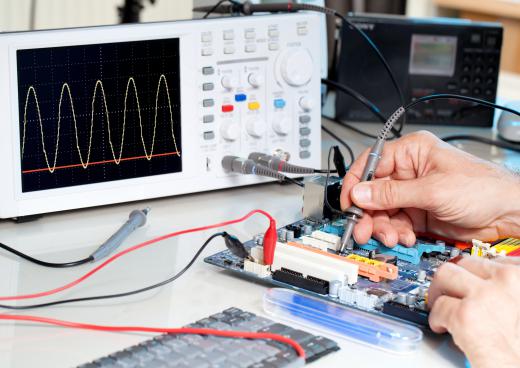A radio frequency (RF) probe is a simple circuit that allows a voltmeter to indicate relative amplitudes of RF signals on different parts of an RF circuit. It is a very useful test tool in a radio laboratory and usually has a capacitor direct current (DC) decoupling input that isolates any DC from the resulting measured voltage. The RF probe may be used to test oscillators, receivers, and transmitters.
In the active electronic circuit, the RF signal may be an alternating current (AC) or an AC signal added to a DC level. A class A amplifier or a linear amplifier with a no-signal or quiet DC level at roughly half the DC supply voltage will generate an output that is a DC level with superimposed AC signal measured using an RF probe to isolate the effect of the DC component. For instance, a linear amplifier with a 12-volt (V) power supply may have a quiet DC output level of about 6 volts direct current (VDC). When there is no RF input signal, the output is pure DC, but even if there is DC, the RF probe meter will indicate 0 V. Once there is an RF input and consequential output, the RF probe meter may indicate a DC voltage related to the peak level of the RF signal.

Radio frequency oscillation (RFO) is a very important part of RF receivers and transmitters. RF oscillators are circuits that generate RF locally on the receivers where they are referred to as RF local oscillators. In the transmitters, these oscillators are referred to as RF carrier generators. The RF detector can be a simple capacitor input circuit that has a clamping high-frequency diode that acts to short out the negative cycle while allowing the positive portion of the RF cycle to reach the DC measurement circuit. This results in a DC voltage with an average level that is approximately equal to the peak level of the RF signal.
The RF detector can be an RF rectifier that simply produces the average peak level of the RF signal. The amplitude modulation (AM) RF carrier has an average peak level that is proportional to the message. By using the RF rectifier as an RF AM detector, the original message can be reproduced. There is a very small passive circuit that uses a wire antenna connected to a simple RF diode as an AM detector, which includes a resistor and a capacitor to shape the result as low-power audio. With an earphone, the result is a simple receiver with no active parts, and this passive receiver works only when there is a strong AM carrier in the area.
Electronic test equipment use different types of RF probes. The oscilloscope displays a periodic waveform on a two-dimensional screen with amplitude on the vertical and timescale on the horizontal axis. There is the high-impedance RF probe used for oscilloscopes that assures the test equipment does not alter the measured signal.
